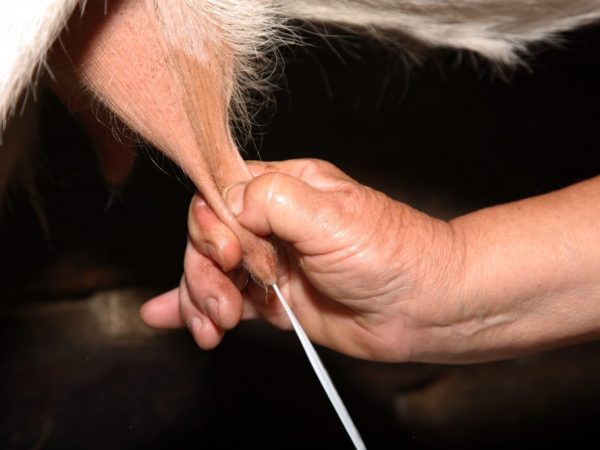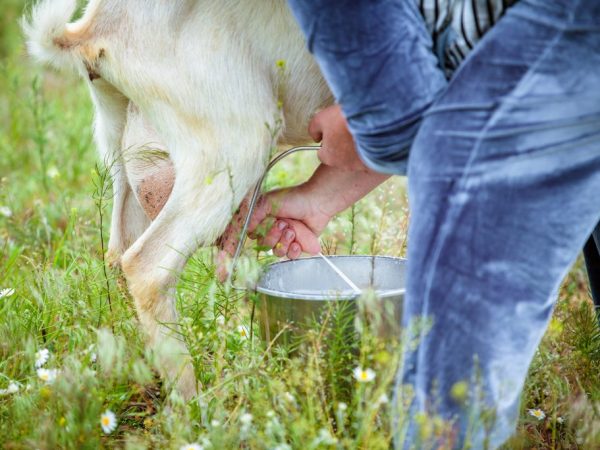Rules for milking goats before and immediately after lambing
Pregnancy in different pets may differ in certain nuances. In artiodactyls, this is most often associated with milk yield. Many farmers are wondering - how to milk a goat before lambing and is it possible to do it at all?

Milking goats before and immediately after lambing
The lactation product of cattle is produced by the body primarily for feeding the offspring. Over a long period of time, a person has managed to adapt this feature of the body of artiodactyls to suit his needs.
However, even considering such circumstances, one should not forget about the original purpose of lactation in cows and goats. When asked how many times to milk a goat after lambing and whether it is necessary to leave the kids with their mother, each experienced herder answers differently, but there are still general rules for milking before and after giving birth.
Running and feeding before lambing
The start is considered the procedure of gradual reduction of milk yield before lambing.
The fact is that the body of a pregnant female loses a lot of nutrients in the process of bearing kids. If it does not reduce the amount of product during milking, the pet's body can quickly become depleted. The negative consequences of this can be the loss of milk, miscarriage or even the death of a goat. A gradual decrease in milking will allow the goat to gain strength to bear or feed the kids.
If the milk level remains the same throughout the pregnancy, then the female needs to be started on her own within a month. For this, the goat's diet is being revised. The percentage of juicy feed and vegetables is reduced. The concentrated feed should be left out - without it, the goat will not be able to get enough calories for gestation. After the cessation of lactation, you can resume feeding with herbs and vegetables, but three to four days before giving birth, you should again remove them from the diet.
Remember to start the goat gradually. Immediate refusal of milking can put the animal in a stressful state. If the cloven-hoofed animal has a good weight, then it is better to start reducing the daily milk ration one month before lambing. A lean animal may take two months to successfully launch.
The first step in the startup procedure is to reduce the number of milk yields per day. From three times the goat is transferred to two-time milking, and a few days later - one-time. After switching to once a day, milking can be done every two days, gradually decreasing to zero.
The second aspect of the launch procedure is the volume of milk per milk yield. The goat should be slightly underfilled every day. However, be careful, due to too much milk left in the udder, inflammation of the ducts can begin. Examine the animal throughout the entire run - if the udder is hardened, then all milk should be milked. When the goat stops giving more than a glass of milk per day, you can stop milking it.
There is a universal launch schedule that pastoralists customize for their pets:
- the first week of launch - one-time milking, the amount of milk is reduced to one liter;
- second week of launch - milk yield takes place once every one and a half days, the amount of milk is reduced to half a liter;
- the third week of launch - milked every two days, the amount of milk is reduced to three hundred grams;
- fourth week of launch - milk yield occurs only when necessary.
When starting up, gradualness is an important factor. You can't just quit milking the animal - from this the udder can harden, there are threats of inflammation and mastitis.
If the milkiness of the goat continues right up to the lambing, do not worry. In these cases, it is not necessary to milk the udder dry - useful components in lactose may be needed by an artiodactyl for the good development of the kids.
If the animal milked during pregnancy, then a breakdown may occur in the body and such a goat, most likely, will no longer give milk. To avoid this, keep your pet from unnecessary stress.
How to milk a goat after lambing

First milk for babies
If the goat is a dairy breed, then the first flock is possible immediately after lambing.
Meat species of goats can be milked in two to three months. Those breeds that are bred for wool, can begin to produce stable milk yield only four months after the kids are born. To milk a goat properly, you need to adhere to certain rules.
The amount of milk in an animal will depend on how many kids are in the litter and how much the mother has. The first time an artiodactyl is milked immediately after giving birth, but not for sale, but in order to feed the cubs. If the goal of breeding goats is milk, then do not allow babies to self-feed. The kids need to be kept in a separate enclosure, but taking into account that they will see the female.
If the cubs milk the goat on their own, they can injure her with horns or teeth. In addition, newborn kids do not know the measure of consumption and if they do not go to slaughter, then it is better not to let them near the goat. Such individuals are fed using a special bottle with a nipple. In order for the kids to grow properly, monitor the amount of milk consumed. Do not reduce the daily rate to a critical level - the cubs are not yet able to eat conventional dry food and may die.
In the first few days after giving birth, the goat's lactation level increases dramatically, so they should be milked at least five times a day. The kids need four meals a day, and the rest of the milk can be sold. It can take several hours in the first weeks. It mainly depends on how much the goat weighs and how it was fed during this time.
For the first month, young animals drink pure milk to obtain all the nutrients. However, already forty days of life, milk can be diluted with warm boiled water. By the age of three months, the stomachs of the kids are finally strengthened, and the young can begin to eat adult food. At the same time, females are transferred to three milking times, since their milk production decreases. These simple rules will help you milk your goat properly without harming your health.
Methods for increasing lactation in a goat after lambing
The level of milk production of goats after giving birth is considered to be the highest for the period of the animal's life. However, after a couple of months, cattle breeders notice a decrease in lactation. This is usually due to a violation of sanitary standards for keeping artiodactyls or improper milking. To get more profit, you should adhere to these rules:
- Milking should take place at the same time. Goat owners advise milking the animal three to four times a day. This helps to increase milk yield even in dairy species.
- The diet of a lactating female should be balanced. After lambing, the amount of concentrated feed in the diet of artiodactyls decreases, and succulent feed and greens come to replace it. For greater milk consistency, feed your goat carrots, cabbage, beets and other fresh vegetables.Watch the weight of the animal - obesity can reduce the amount of milk produced. Lactation can be negatively affected by potatoes, so they should be eliminated from the diet. You can give the goat chamomile decoctions, tunpeps and legumes. Lack of vitamins and minerals can also negatively affect the quality and quantity of milk. To avoid vitamin deficiency, feed your goats bone meal, chalk, and fish oil.
- Follow the rules for milking goats. Remember to pet the animal and massage the udder before and after milking. The first jets are lowered to the ground, this clears the nipples from dirt. Milk should be milked to the last drop - the last portions of the product contain the highest amount of fat. Experienced farmers say that goats are milked better outdoors.
It doesn't take much effort to milk a goat properly. This may well be done by an inexperienced herder, observing these simple rules.
Additional tips for beginners
- After massaging the udder, brush it with petroleum jelly. This will serve as a good preventive treatment for cracks and infection.
- The animal should be milked by squeezing the nipple with the index and thumb at the very base. Movements should be fast and rhythmic.
- If the cloven-hoofed animal is restless, shifts from foot to foot or kicks during milking, then you need to equip a special pen for this procedure. Some farmers advise milking while feeding the animal.
- Talk out loud to the goat, call it by name. The voice and monotonous intonations calm the animal.
- Do not use strong-smelling perfumes or deodorants before milking. Wash and warm your hands thoroughly.
- It is best to milk goats by sitting down to them from the right side. In this case, the animal sees you and experiences less stress.


